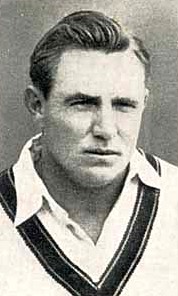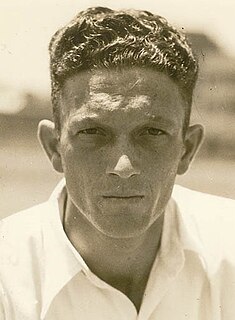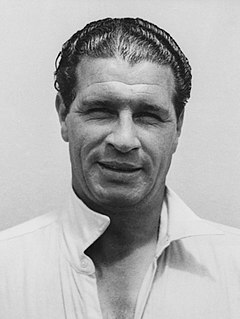Related Research Articles

Raymond Russell Lindwall was a cricketer who represented Australia in 61 Tests from 1946 to 1960. He is widely regarded as one of the greatest fast bowlers of all time. He also played top-flight rugby league football with St. George, appearing in two grand finals for the club before retiring to fully concentrate on Test cricket.

Arthur Lindsay Hassett was a cricketer who played for Victoria and Australia. The diminutive Hassett was an elegant middle-order batsman, described by Wisden as, "... a master of nearly every stroke ... his superb timing, nimble footwork and strong wrists enabled him to make batting look a simple matter". His sporting career at school singled him out as a precocious talent, but he took a number of seasons to secure a regular place in first-class cricket and initially struggled to make large scores. Selected for the 1938 tour of England with only one first-class century to his name, Hassett established himself with three consecutive first-class tons at the start of the campaign. Although he struggled in the Tests, he played a crucial role in Australia's win in the Fourth Test, with a composed display in the run-chase which sealed the retention of the Ashes. Upon returning to Australia, he distinguished himself in domestic cricket with a series of high scores, becoming the only player to score two centuries in a match against Bill O'Reilly—widely regarded as the best bowler in the world.

Ronald Arthur Saggers was an Australian cricketer who played for New South Wales. He played briefly for the Australian team, playing six Tests between 1948 and 1950. In his Test cricket career he made 24 dismissals and scored 30 runs at an average of 10.00.

Donald Tallon was an Australian cricketer who played 21 Test matches as a wicket-keeper between 1946 and 1953. He was widely regarded by his contemporaries as Australia's finest ever wicket-keeper and one of the best in Test history, with an understated style, an ability to anticipate the flight, length and spin of the ball and an efficient stumping technique. Tallon toured England as part of Don Bradman's Invincibles of 1948 and was recognised as one of the Wisden Cricketers of the Year in 1949 for his performances during that season. During his Test career, Tallon made 58 dismissals comprising 50 catches and 8 stumpings.

Peter John Parnell Burge was an Australian cricketer who played in 42 Test matches between 1955 and 1966. After retiring as a player he became a highly respected match referee, overseeing 25 Tests and 63 One Day Internationals.

Charles George Macartney was an Australian cricketer who played in 35 Test matches between 1907 and 1926. He was known as "The Governor-General" in reference to his authoritative batting style and his flamboyant strokeplay, which drew comparisons with his close friend and role model Victor Trumper, regarded as one of the most elegant batsmen in cricketing history. Sir Donald Bradman—generally regarded as the greatest batsman in history—cited Macartney's dynamic batting as an inspiration in his cricket career.

Richard Charles Motz was a New Zealand cricketer. A right-arm fast bowler and hard-hitting lower order batsman, Motz played 32 Test matches for the New Zealand cricket team between 1961 and 1969. He was the first bowler for New Zealand to take 100 wickets in Test cricket.

Bruce Alexander Grenfell Murray is a former Test cricketer for New Zealand who played 13 Tests as a right-handed opening batsman between 1968 and 1971. He was a school principal in the Wellington area from 1981 to 2002, and the author of several geography textbooks. Since his retirement from teaching he has been a cricket administrator in Wellington and a historian.
Bryan William Yuile is a retired cricketer who played 17 Test matches for New Zealand in the 1960s. He played first-class cricket from 1959 to 1972, until his religious objection to playing on Sundays led to the end of his career.

Ernest Raymond Herbert Toshack was an Australian cricketer who played in 12 Tests from 1946 to 1948. A left arm medium paced bowler known for his accuracy and stamina in the application of leg theory, Toshack was a member of Don Bradman's "Invincibles" that toured England in 1948 without being defeated. Toshack reinforced the Australian new ball attack of Ray Lindwall and Keith Miller.

Douglas Thomas Ring was an Australian cricketer who played for Victoria and for Australia in 13 Test matches between 1948 and 1953. In 129 first-class cricket matches, he took 426 wickets bowling leg spin, and he had a top score of 145 runs, which was the only century of his career.
Roy Ivan Harford is a former New Zealand cricketer who played in three Tests against India in 1967–68. He played first-class cricket in New Zealand from 1965 to 1968.
Mark Gordon Burgess is a New Zealand former cricketer who captained the New Zealand cricket team from 1978 to 1980. He was a right-handed batsman, and bowled right-arm off-breaks. He played in New Zealand's first One Day International (ODI).
The New Zealand cricket team toured England in the 1965 season, playing three Test matches in the first half of a damp summer. England later hosted a second three-match series against South Africa, the first time two Test series were played in a single English cricket season since the 1912 Triangular Tournament.
The New Zealand cricket team toured England in the 1969 season to play a three-match Test series against England. The New Zealanders played in the second half of the English season: the England cricket team played three Test matches against the West Indies cricket team in the earlier part of the season, winning that series by 2–0 with one match drawn - see the article West Indian cricket team in England in 1969.
The New Zealand national cricket team toured South Africa from October 1961 to February 1962 and played a five-match Test series against the South Africa national cricket team. The series was drawn 2–2, with New Zealand's victory in the third Test the team's first Test match win outside their home country. New Zealand captain John Reid scored a total of 1,915 runs during the tour, setting a record for the most runs scored in South Africa by a touring batsman. The tour was the second to South Africa by a team from New Zealand, the previous tour having taken place in 1953–54.
The India national cricket team toured Australia in the 1967–68 season and played a four-match Test series against Australia. Australia won the Test series 4-0.

Leah Joy Poulton is an Australian cricketer who plays for New South Wales and Australia. She is a specialist batsman who usually opens the batting.
The New Zealand cricket team toured India in the 1964-65 cricket season. They played four Test matches against the Indian cricket team, with India winning one match and the other three being drawn.
The Pakistan national cricket team toured New Zealand in January and February 1973 and played a three-match Test series against the New Zealand national cricket team. Pakistan won the series 1-0. It was their first Test series win outside Pakistan. In addition, a Limited Overs International (LOI) took place between the second and third Tests; this match was the inaugural LOI of both teams.
References
- 1 2 3 4 5 Wisden 1969, pp. 859–63.
- 1 2 3 Don Neely & Richard Payne, Men in White: The History of New Zealand International Cricket, 1894–1985, Moa, Auckland, 1986, pp. 373–377.
- ↑ "South Australia v New Zealanders 1967-68". CricketArchive. Retrieved 2 September 2015.
- ↑ "Victoria v New Zealanders 1967-68". CricketArchive. Retrieved 2 September 2015.